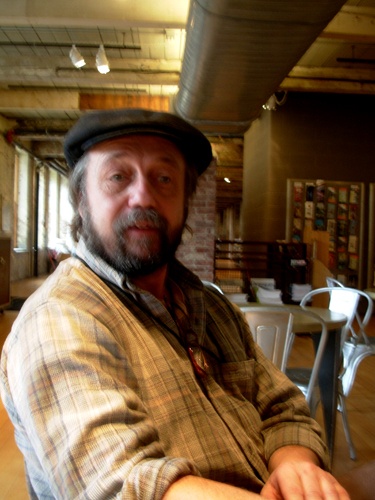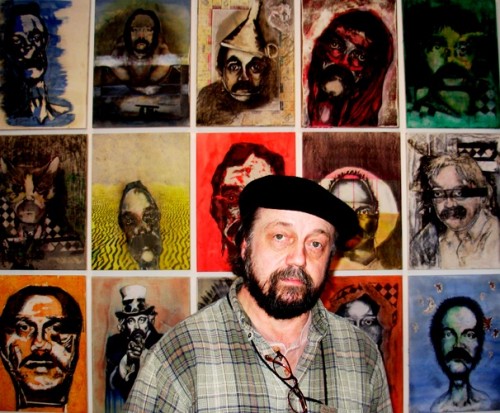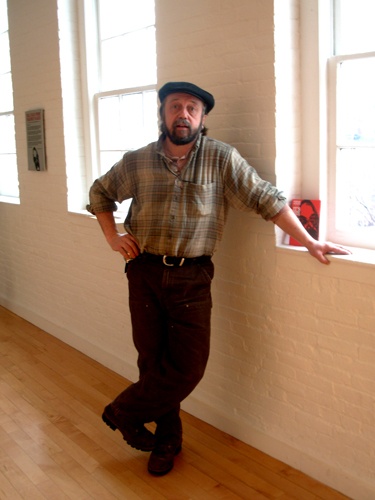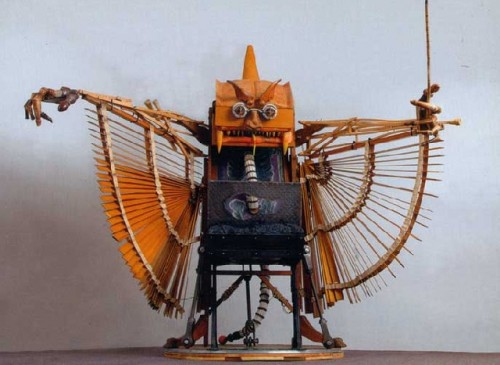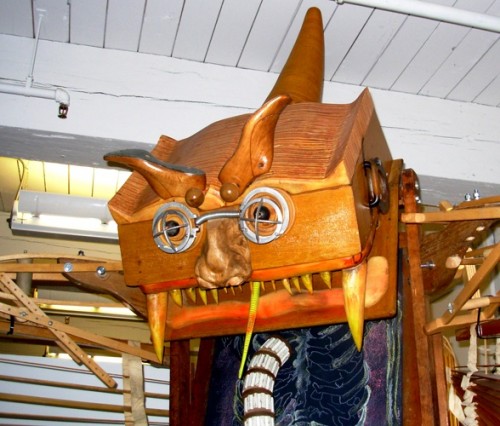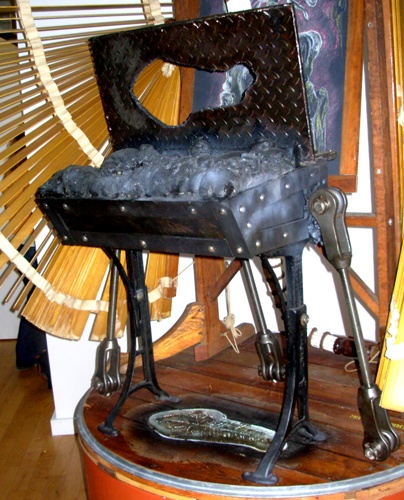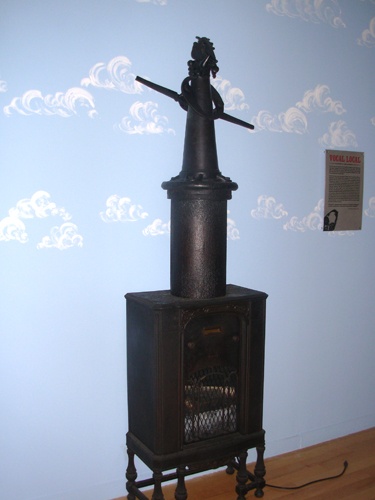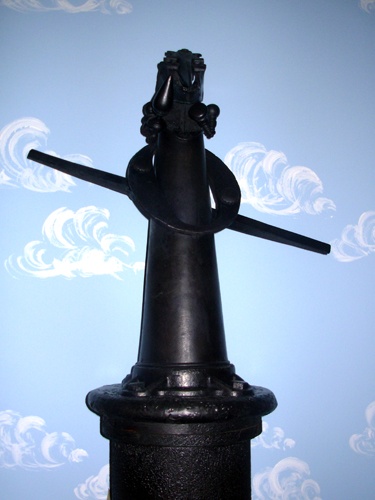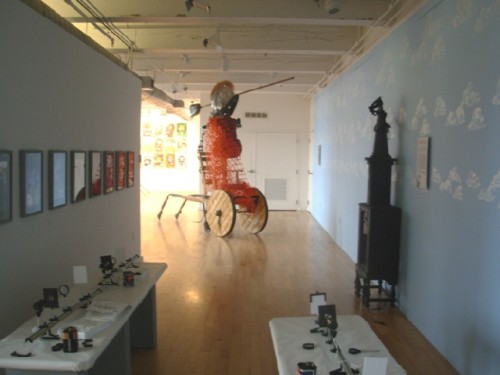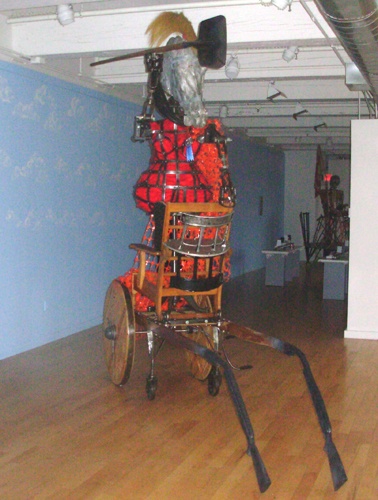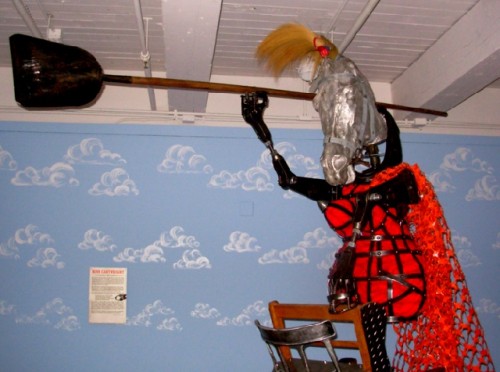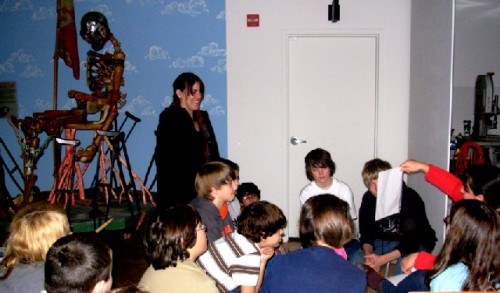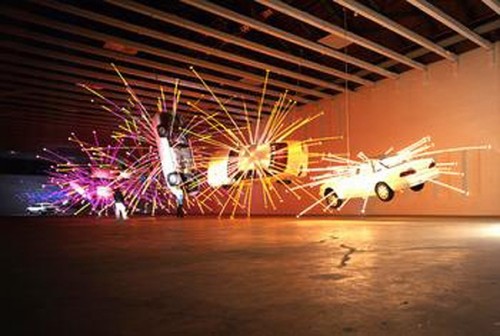Sculptures of Mass MoCA's Richard Criddle
A Little Shop of Horrors
By: Charles Giuliano - Feb 09, 2008
During a rare lull between exhibitions, Richard Criddle, who, since 1998, has been Director of Fabrication & Art Installation, for the Massachusetts Museum of Contemporary Art, took several hours to discuss a broad range of topics. The primary purpose of the meeting was to view an exhibition of his figurative, narrative, assemblages comprising the exhibition "It's Rude to Stare: Drawings and Sculpture by Richard Criddle" which remains on view in Kidspace in Mass MoCA through February 24.
The rather enticing title is derived from a childhood experience when Criddle was shocked to encounter a severely disfigured individual when he and his Mum were walking along the street. He was fixated by the experience until she jerked him along with a stern reprimand "Don't you know it's rude to stare."
Along with director, Joe Thompson, and a core of others, Criddle has been with the sprawling contemporary art museum in North Adams since the doors opened to the public. He has been involved in all aspects of planning and installing exhibitions with some of the world's leading contemporary artists. But he is quick to phrase his involvement not as "I" but rather as "We." Describing a dynamic of working as a team in which he is the boss of a crew.
While the museum, as an institution, is still very young and endured widely reported growing pains, it has been known for risk taking, There have been staff and curatorial turnovers but Criddle described a dynamic in which he, Thompson, and other senior staff members, bring a measure of balance and experience to discussions of projects which take an average of four years of development. Based on that steep learning curve there is now a more focused dialogue on what is feasible, as well as, what is not. There were hard lessons resulting from the breakdown of the Christoph Buchel affair which Criddle observed had impacted not just Mass MoCA but museums around the world initiating complex projects with contemporary artists.
A rather private man, with a rollicking sense of humor, and a very British love of colorful language, he conveyed that writing is a torture and that he does not often meet with the media. With a twinkle he quoted Oscar Wilde who described England and America as two great nations separated by a common language. During the Buchel incident, which he is anxious to put in the past, he was grilled by lawyers and the media. He recalled a tough interview with Jeff Edgers of the Boston Globe and did not enjoy being quoted out of context as looking for another job. But it is now past tense and that which does not destroy us makes us strong. He describes two tough weeks, of ten hour, six day efforts to clear the gallery of the aborted "Training Ground for Democracy."
What became of the house, one of the many elements, including the former lobby of the North Adams Cinema, which were apart of the aborted project? Was it somehow salvaged I asked? Instead Criddle described demolishing it with a fork lift and tearing it apart with chain saws. "It was an old house and rather well built" he recalled implying that it put up a good fight. It sounded like draining but cathartic labor.
Since that hard time his spirits, and those of Mass MoCA in general, appear to have soared. Having notched a decade with the museum I asked if there was a sense that the initial phase has now passed? He and the crew are about to undertake the development of a new building with more or less permanent installations by Sol LeWitt which are anticipated to add new space and boost annual attendance.
As we sat in the café, to give some dimension to his responsibilities, looking around he stated that "I personally welded the legs of every chair and table in this area." Virtually anything that entails fabrication, from the upside down hanging trees which greet visitors entering the museum, to flipping cars as a part of an installation, to the smallest nuts and bolts details, in one form or another, fall under Criddle's unique and gifted domain. He described how, except for a brief stretch driving a truck, he has earned a living, since he was 17, applying his skills and trade as a sculptor, fabricator, and master craftsman.
So it was a special delight to see how these elements come together while viewing his works for Kidspace. During the week, as the name implies, it is an area for visiting groups of students. There was a session in progress while we visited. On weekends it is open to visitors. The project took some two years to put together and was uniquely inspired by its special audience.
The large sculptures, assembled from an eclectic mix of found and fabricated elements, draw on fantasy and vivid memories of the often cruel and terrifying individuals and experiences of Criddle's childhood. He appears to draw upon a rich Dickensian cast of characters which is particularly British in its vivid and horrific elements. The characters also evoke those in Dr. Heinrich Hoffmann's classic German children's book "Struwwelpeter." In writing about the works, there are elaborate wall texts for each piece, he described a childhood as a "Lost Boy" but lacked a Peter Pan to whisk him off to Never Never Land. Criddle evokes a terrifying cast of evil spirited teachers and frightening neighbors who were the surrogates for Captain Hook, the Wicked Witch of the West, and other monsters who prey on little boys.
In a text for the show Criddle wrote that "We each still carry within us the child we once were. I am the long since grown up little boy who was once afraid of the shadows of tree branches in the moonlight on my bedroom ceiling. I was petrified by the hideous faces that hid in the half-light amongst the patterns of the wallpaper. Today I make sculpture that embraces that fear."
Describing the sculpture "Vocal Local" in which a cast bronze figure is mounted above a stove with a plug in simulation of a burning hearth he describes the terrifying source of inspiration. "No one was ever spared. You could be caught, by her sharp eye and razor tongue, at the corner shop, the post office, the front gate or on the way to school. Often she could be heard before she was ever seen. Avoid her, discretely, politely, a skill to be learned at an early age.
"Cast in bronze, she is burning to speak. She is a gossip. She is a busybody; a loud mouth and a spreader of rumors and lies. Her position, like her opinion is fixed and rigid, un-shakeable and her wingspan is ready to cut you down like a machete. She wears a skirt fashioned from a megaphone. An accessory required for speaking to the crowd and communicating her pungent doctrines from a soapboxÂ…"
While most of the elements in the sculptures are joined wood or welded metal I was intrigued to learn that the top of "Vocal Local" had been cast in bronze at Berkshire Fine Art Foundry in Pittsfield. I also recognized the cast aluminum horse's head of another piece as cribbed from the Elgin Marbles in the British Museum. With a laugh Criddle admitted as such stating that he had cast the horse's head as a class demonstration while teaching. Foundry work had been his focus at the Royal College of Art where he was an assistant to the Master Founder, Tissa Ranasinghe. In 1980, he was co founder of Lippiat Foundry, Ltd. in Gloucestershire. In 1985, with his wife, Debora Coombs, a specialist in stained glass, he started London Fields Studios. And, in 1988, with the sculptor, Ian Payne, he started Meatmore Sculpture Services Ltd. He created many of his own monumental sculpture pieces and describes literally tons of works on public view in the Midlands of England as well as in the United States. In 1992, he created a series of major works along the Black Country Route for the Borough of Wolverhampton in England.
In the post Greenbergian, formalist aspects of the dialectics of main stream contemporary art critical thinking, I suggested, there is little respect for the personal and narrative in the "high art" of the avant-garde. Particularly such quirky and funky work such as his. Criddle rebounded to this tough question with compelling rope-a-dope. He strongly debated the suggestion and discussed several of his Heroes and sources of inspiration; starting with formalist British sculptor, Anthony Caro.
"Anthony Caro" I blurted out. "Surely there is no humor or narrative in that work."
Criddle responded "I beg to differ. Look at the series 'Barbarians.' Caro was driving around London and visiting a shop he came on a group of old gym, horses used for vaulting, like we used to do in school. He bought the lot, which is what you can do if you have the money, and brought them back to the studio. He used them as a starting point and armature. It evolved into a body of work which despite the usual expectations had very little steel and instead was mostly made with clay and wood. I was very impressed by the fact that at his age he refused to be typecast. He was in his 80s and flipping the bird at the critics by making a series of figurative pieces."
In a December 13, 2002 review of Caro's work in the New York Times Roberta Smith wrote that "The history of staunch abstractionists who reverted to representation in the later parts of their careers is long and often inspiring, stretching from Kazimir Malevich to Philip Guston. Sometime in the 1990's, the British sculptor Anthony Caro joined the list. His latest show features nearly life-size equestrian figures built from fragments of wood and terra cotta on gymnasts vaulting horses; it suggests, as previous exhibitions have not, that he is playing for keeps.
"Playing is the operative word. After tackling the Trojan Wars and the Last Judgment, Mr. Caro has settled on nonspecific barbarians who are none too threatening. Comical, inept and fatally encumbered by their builds, arms and armor, they are more Sancho Panza than Richard III and have the spirit of carousel animals or oversize toys."
Other heroes that Criddle discussed included H. C. Westermann the American sculptor known for witty combinations of materials and the use of narrative. As well as, David Smith, particularly his "Voltri" series. In abandoned factories near Genoa, Italy, in 1962, Smith made 27 welded steel sculptures in just 30 days. Many feel that it was his most inventive and witty body of work. "Smith was like a mouse locked up in a cheese factory" Criddle commented.
I asked how he managed to find the time for his own work and whether the intense involvement in helping other artists to realize their projects sapped into his creative juices? He described working at Mass MoCA as the day gig and what goes with the territory as a "Bread Winner." That in a relationship between two artists with two kids one partner has to be relied upon to bring home the bacon. But he leaves the job behind on weekends, and during down time between Mass MoCA projects and its related travel, to do his own work. In the house/ studio in Vermont he also has the space to collect the odd materials that eventually find their way into the sculptures. We wondered if he drove around on Trash Night and scavenged recycled materials. But he regretted that you don't have that opportunity in the country unlike discarded treasures piled on the sidewalks of New York or London.
Criddle was born, in 1955, in Southend-on-Sea, Essex, England. He was a 1977 graduate of the Central School of Art and Design, and holds a 1985, Post Graduate Diploma in Sculpture, from the Royal Academy Schools. Just how did he end up in the Berkshires? He explained that it is because of his wife, Debora Coombs, that they arrived here 12 years ago. She was in the States because of a commission to design windows for the Catholic Cathedral in Portland, Oregon. For the project Coombs worked with the Cummings Studios in North Adams. "Most of the studios in the States who work with stained glass do conservation work" he explained. "Those who do new design work are few and far between. I was tenured at the time (Cheltenham & Gloucester College of Higher Education, Cheltenham, England) and we came over for the dedication of the first phase of the windows."
In 1996, he was an artist in residence at the Massachusetts College of Liberal Arts in North Adams and established a sculpture studio at Mass MoCA. Their London Fields Studios relocated to Vermont, where they live, and was renamed Coombs Criddle Associates. By 1998 he was appointed to the position at Mass MoCA which he has held ever since. It was not that he ever aspired to work with a museum. Rather it was a matter of the right time and place. Overall, it has proved to be a marvelous fit. Were he involved with most museums in his current position he would be hanging pictures on the wall. But, at Mass MoCA, he is involved in all aspects of projects with artists.
"When an artist sends us plans for a Dragon Boat we make it" he said. "Or we hang trees upside down and suspend Ford Taurus cars from the ceiling. I say 'we' because we are a team. You don't do it on your own. It's a funny old job and I'm the captain of the team."
Forming a question I described a perception that many artists working with installations or art/ science and technology often don't know what they are doing. They may have a general idea but are then dependent on individuals like Criddle to execute their visions. He disputed that notion. "Most artists we deal with have a very clear idea of the end goal. We do our level best to host, foster and incubate that process. For example, when Cai Guo Qiang worked with us I was presented with drawings and sketches of what he wanted for the large gallery in Building Five. It so happened that early on we made a model for the space on a scale of a half inch to the foot. The actual model is 16' long. I went on the internet and purchased a bunch of model cars that were also on the scale of a half inch to the foot. Using the kind of flexible aluminum wire which sculptors use to form armatures I was able to draw three dimensionally and place nine Ford Taurus cars in the space using the model. When Cai came back to Mass MoCA he was able to manipulate the model cars and get them precisely how he wanted them."
Once the artist was satisfied with the design "He was able to go away and we got the cars into the building. Over the years we have worked with a number of specialists we are able to call on for projects including contractors, riggers and crane operators. Using the model we measured precisely and were able to mount the cars in the space. When Cai came back he made just one adjustment to a car. That project was the brain child of the artist. He spoke little English but we were able to work together. It is a collaborative effort. It is less like working in a museum and more like what would happen on a set with a movie crew. It is somewhat of a myth that the artists don't know what they are doing. Before coming here I had never worked in a museum but I bring 35 years of experience as a sculptor to the mix.
"That may include how to put a two ton elephant through a window and then dragging it along a floor. There is never a dull moment. You pitch in together. A lot of what goes on here is an extension of my studio practice. What needs to be done can be done under our roof. Museums in New York and other major cities don't have the space and work shops to do what we do here. They have to bid out the work. We do just about everything you see in our own workshops. We practice in house problem solving. We are constantly exploring the parameters of resourcefulness."
When a program depends to such a great extent on commissioned work and initiating projects with artists there are risks involved. What initially seems like a great idea may not be so terrific in its final resolution. For the Mass MoCA Team there is vulnerability and sensitivity involved. It is the job of the critic to make aesthetic judgments, and a tough review of a show they put their heart and soul in, may result in strained relations. Also artists are not equally a joy to work with. Buchel proved to the worst case scenario of a nightmare relationship with an artist but, between the cracks, Criddle conveys the very human feeling that some artists are more of a pleasure to deal with than others. He is not equally enthusiastic about every project. But when pressed on the matter he quoted from the BBC series "House of Cards" in which the politician, Chief Whip, Francis Urquhart, played by the late Ian Richardson, says to the media "You might think that" about some controversy in question "I couldn't possibly comment."
While Criddle and the Mass MoCA crew do a remarkable amount of on site fabrication, perhaps more than any comparable institution in the world, part of that is about being cost effective and stretching very limited resources. He discussed the Ann Hamilton project in which devices attached to the ceiling slowly dispensed sheets of paper which floated down into the space and piled up on the floor. They were originally intended to be about waist high but the fire department limited that to about ankle height which altered the impact of the installation. Criddle described how Hamilton had a devise fabricated that proved to be so expensive that the museum could never have afforded as many as she envisioned. With the artist's permission Criddle and a local engineer took the devise apart and retooled it with off the shelf elements such as parts of a garage door automatic opening mechanism. It is rather like the first class auto mechanic who knows that an expensive part required for a Ferrari will also work with one from a Ford at a fraction of the price.
"We are here forty hours a week helping artists to realize their dreams," Criddle said. Dream on.

